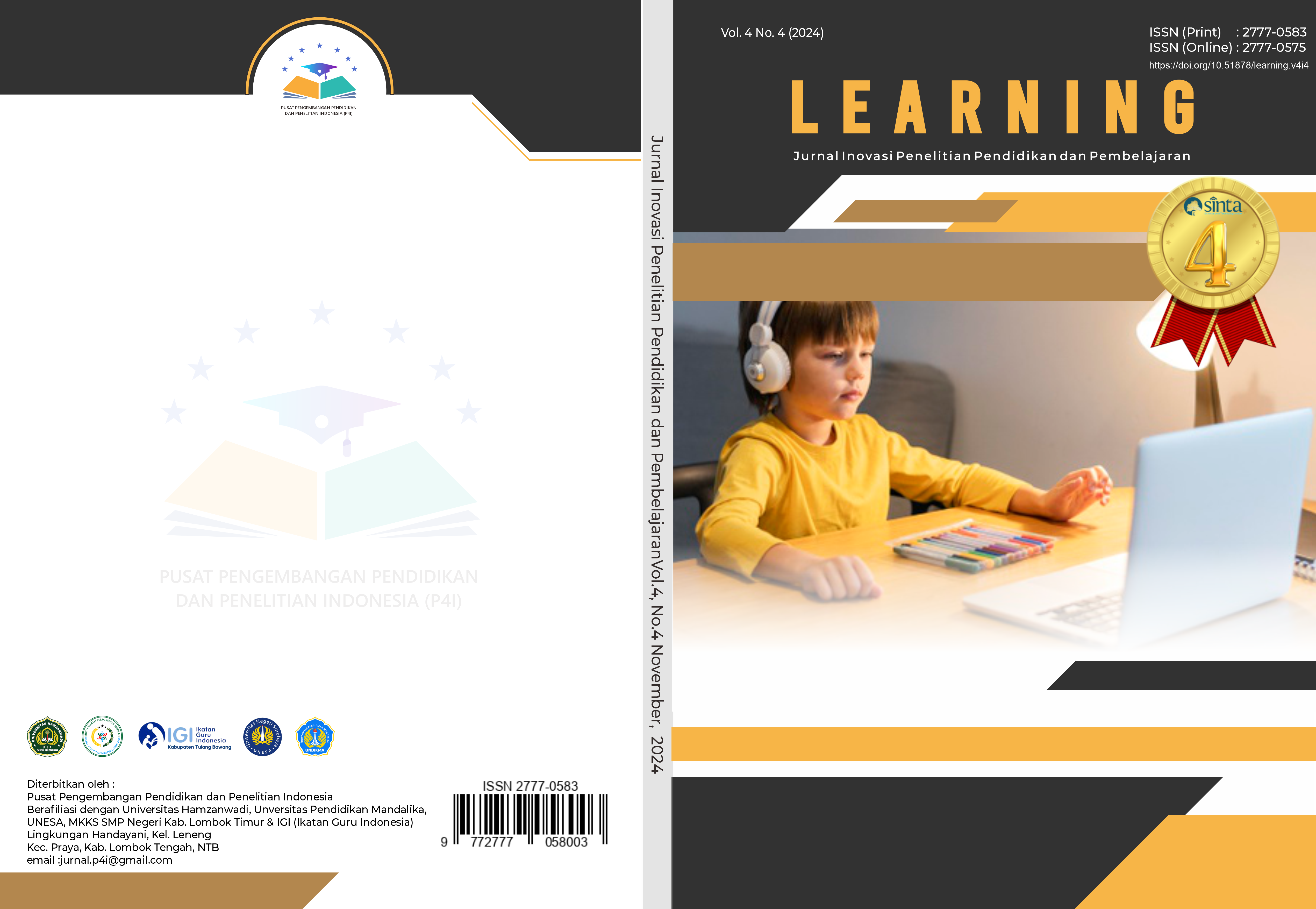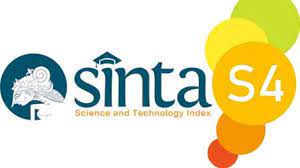TREN PEMBELAJARAN BERDIFERENSIASI DI SEKOLAH MENENGAH ATAS: TINJAUAN LITERATUR ANALISIS BIBLIOMETRIK DARI 2019 HINGGA 2023
DOI:
https://doi.org/10.51878/learning.v4i4.3623Keywords:
Differentiated instruction, differentiated learning, high schoolAbstract
This study is a literature study using bibliometric analysis to evaluate the trend of Differentiated Instruction (DI) learning in high schools from 2019 to 2023 with quantitative methods. Publication and citation data were analyzed to assess the influence and contribution of the research. The PRISMA (Preferred Reporting Items for Systematic Review and Meta-Analysis) methodology was used to ensure quality and transparency through the stages of identification, screening, eligibility assessment, and inclusion. Data were compiled using Mendeley in RIS format and analyzed with VOSviewer for citation analysis, co-occurrence, and co-authorship. This study reviewed 144 articles from Science Direct, Publish or Perish, Mendeley Reference, Taylor & Francis, Sage Journal, Wiley Journal, and Eric Education Sciences, with 35 articles meeting the inclusion criteria. The results showed an increasing publication trend, with Differentiated Instruction (DI) as the main topic. Countries such as Australia, the Netherlands, and Germany played a significant role. The most frequently used methods were qualitative and quantitative. VOSviewer visualization reveals DI's links to personalized learning, inclusivity, student confidence, and diversity in secondary education.
ABSTRAK
Penelitian ini merupakan studi literatur yang menggunakan analisis bibliometrik untuk mengevaluasi tren pembelajaran Differentiated Instruction (DI) di sekolah menengah atas dari tahun 2019 hingga 2023 dengan metode kuantitatif. Data publikasi dan sitasi dianalisis untuk menilai pengaruh dan kontribusi penelitian. Metodologi PRISMA (Preferred Reporting Items for Systematic Review and Meta-Analysis) digunakan untuk memastikan kualitas dan transparansi melalui tahap identifikasi, penyaringan, penilaian kelayakan, dan inklusi. Data dikompilasi menggunakan Mendeley dalam format RIS dan dianalisis dengan VOSviewer untuk analisis kutipan, co-occurrence, dan co-authorship. Penelitian ini meninjau 144 artikel dari Publish or Perish, Mendeley Reference dan Taylor & Francis dengan 35 artikel yang memenuhi kriteria inklusi. Hasil menunjukkan tren publikasi yang meningkat, dengan Differentiated Instruction (DI) sebagai topik utama. Negara seperti Australia, Belanda, dan Jerman berperan signifikan. Metode yang paling sering digunakan adalah kualitatif dan kuantitatif. Visualisasi VOSviewer mengungkap keterkaitan DI dengan pembelajaran yang dipersonalisasi, inklusivitas, kepercayaan diri siswa, dan keragaman di pendidikan menengah.
Downloads
References
Aikaterini, T. A., & Makrina, Z. (2022). Differentiated Instruction and Portfolio Assessment: Motivating Young Greek-Romani Students in the English Class. World Journal of English Language, 12(1), 258. https://doi.org/10.5430/wjel.v12n1p258
Al-Makahleh, A. A., Smadi, A. M., & Momani, M. (2023). The Effectiveness of a Training Program Using Differentiated Instruction to Improve the Reading Skill of Jordanian Third Graders With Learning Difficulties. Theory and Practice in Language Studies, 13(9), 2313–2322. https://doi.org/10.17507/tpls.1309.18
Am, Muh. A., Hadi, S., Istiyono, E., & Retnawati, H. (2023). Does differentiated instruction affect learning outcome Systematic review and meta-analysis. Journal of Pedagogical Research, 5. https://doi.org/10.33902/JPR.202322021
Andrean, C. (2023). DESIGNING AND ADAPTING MATERIALS FOR DIFFERENTIATED INSTRUCTION IN ENGLISH LANGUAGE CLASSROOMS: A LITERATURE REVIEW. TELL-US JOURNAL, 9(3), 666–690. https://doi.org/10.22202/tus.2023.v9i3.6996
Angilan, J. (2021). Differentiated Instruction and Students’ Literary Competence: An Experimental Study. Middle Eastern Journal of Research in Education and Social Sciences, 2(2), 110–125. https://doi.org/10.47631/mejress.v2i2.230
Bondie, R. S., Dahnke, C., & Zusho, A. (2019). How Does Changing “One-Size-Fits-All” to Differentiated Instruction Affect Teaching? Review of Research in Education, 43(1), 336–362. https://doi.org/10.3102/0091732X18821130
Casino, F., Dasaklis, T. K., & Patsakis, C. (2019). A systematic literature review of blockchain-based applications: Current status, classification and open issues. Telematics and Informatics, 36, 55–81. https://doi.org/10.1016/j.tele.2018.11.006
Chandra Handa, M. (2019). Leading Differentiated Learning for the Gifted. Roeper Review, 41(2), 102–118. https://doi.org/10.1080/02783193.2019.1585213
Compen, B., De Witte, K., & Schelfhout, W. (2019). The role of teacher professional development in financial literacy education: A systematic literature review. Educational Research Review, 26, 16–31. https://doi.org/10.1016/j.edurev.2018.12.001
Dignath, C., & Veenman, M. V. J. (2021). The Role of Direct Strategy Instruction and Indirect Activation of Self-Regulated Learning—Evidence from Classroom Observation Studies. Educational Psychology Review, 33(2), 489–533. https://doi.org/10.1007/s10648-020-09534-0
Dixon, F. A., Yssel, N., McConnell, J. M., & Hardin, T. (n.d.). Differentiated Instruction, Professional Development, and Teacher Efficacy.
Dorfberger, S., & Eyal, M. (2023). The perception and attitude of educators regarding differentiated teaching in elementary and junior high schools. Social Sciences & Humanities Open, 8(1), 100586. https://doi.org/10.1016/j.ssaho.2023.100586
Easa, E., & Blonder, R. (2022). Development and validation of customized pedagogical kits for high-school chemistry teaching and learning: The redox reaction example. Chemistry Teacher International, 4(1), 71–95. https://doi.org/10.1515/cti-2021-0022
Eikeland, I., & Ohna, S. E. (2022). Differentiation in education: A configurative review. Nordic Journal of Studies in Educational Policy, 8(3), 157–170. https://doi.org/10.1080/20020317.2022.2039351
Endeshaw, A. D. (2023). Examining efl teachers’ knowledge, attitudes and perceived practices of differentiated instruction in English classrooms. Jurnal Cakrawala Pendidikan, 42(3). https://doi.org/10.21831/cp.v42i3.49953
Gervasoni, A., Roche, A., & Downton, A. (n.d.). Differentiating Instruction for Students Who Fail to Thrive in Mathematics: The Impact of a Constructivist-Based Intervention Approach.
Gheyssens, E., Coubergs, C., Griful-Freixenet, J., Engels, N., & Struyven, K. (2022). Differentiated instruction: The diversity of teachers’ philosophy and praxis to adapt teaching to students’ interests, readiness and learning profiles. International Journal of Inclusive Education, 26(14), 1383–1400. https://doi.org/10.1080/13603116.2020.1812739
Gibbs, K. (2023). Voices in practice: Challenges to implementing differentiated instruction by teachers and school leaders in an Australian mainstream secondary school. The Australian Educational Researcher, 50(4), 1217–1232. https://doi.org/10.1007/s13384-022-00551-2
Godor, B. P. (2021). The Many Faces of Teacher Differentiation: Using Q Methodology to Explore Teachers Preferences for Differentiated Instruction. The Teacher Educator, 56(1), 43–60. https://doi.org/10.1080/08878730.2020.1785068
Graham, L. J., De Bruin, K., Lassig, C., & Spandagou, I. (2021). A scoping review of 20 years of research on differentiation: Investigating conceptualisation, characteristics, and methods used. Review of Education, 9(1), 161–198. https://doi.org/10.1002/rev3.3238
Haryani, C. S., & Sudin, A. (n.d.). ANALISIS BIBLIOMETRIK TREN PUBLIKASI DAN TINGKAT KOLABORASI PADA MODEL SITUATION-BASED LEARNING (2010-2019).
Heng, T. T., & Song, L. (2020). A proposed framework for understanding educational change and transfer: Insights from Singapore teachers’ perceptions of differentiated instruction. Journal of Educational Change, 21(4), 595–622. https://doi.org/10.1007/s10833-020-09377-0
Jannah, M., Hakiman, & Ramadhan, S. (2022). Bibliometric Analysis of Islamic Education Research Development in Scopus International Database Publications 2018-2022: Analisis Bibliometrik Perkembangan Penelitian Pendidikan Islam dalam Publikasi Internasional pada Database Scopus 2018-2022. SHAHIH: Journal of Islamicate Multidisciplinary, 7(2), 151–168. https://doi.org/10.22515/shahih.v7i2.6006
Judijanto, L., Mayasari, N., Widiastuti, S., Saputri, D. Y., & Muthmainah, H. N. (2024). Artificial Intelligence dan Big Data: Analisis Bibliometrik terhadap Inovasi Teknologi dan Tantangan Penelitian. Jurnal Multidisiplin West Science, 3(09), 1458–1474. https://doi.org/10.58812/jmws.v3i09.1606
Kamarulzaman, M. H., Kamarudin, M. F., Sharif, M. S. A. M., Esrati, M. Z., Esrati, M. Z., & Yusof, R. (2022). Impact of Differentiated Instruction on the Mathematical Thinking Processes of Gifted and Talented Students. Journal of Education and E-Learning Research, 9(4), 269–277. https://doi.org/10.20448/jeelr.v9i4.4253
Kart, A., & Kart, M. (2021). Academic and Social Effects of Inclusion on Students without Disabilities: A Review of the Literature. Education Sciences, 11(1), 16. https://doi.org/10.3390/educsci11010016
Katherine B. Green. (2022). Using Ability Grouping to Examine the Effects of Differentiated Instruction in an Undergraduate Course in Communication Sciences & Disorders. Teaching and Learning in Communication Sciences and Disorders. https://doi.org/10.30707/TLCSD6.1.1649037808.600819
Klepsch, M., & Seufert, T. (2020). Understanding instructional design effects by differentiated measurement of intrinsic, extraneous, and germane cognitive load. Instructional Science, 48(1), 45–77. https://doi.org/10.1007/s11251-020-09502-9
Kupers, E., De Boer, A., Bakker, A., De Jong, F., & Minnaert, A. (2024). Explaining teachers’ behavioural intentions towards differentiated instruction for inclusion: Using the theory of planned behavior and the self-determination theory. European Journal of Special Needs Education, 39(4), 638–647. https://doi.org/10.1080/08856257.2023.2263717
Lindner, K.-T., & Schwab, S. (2020). Differentiation and individualisation in inclusive education: A systematic review and narrative synthesis. International Journal of Inclusive Education, 1–21. https://doi.org/10.1080/13603116.2020.1813450
Magableh, I. S., & Abdullah, A. (2022). Differentiated instruction effectiveness on the secondary stage students’ reading comprehension proficiency level in Jordan. International Journal of Evaluation and Research in Education (IJERE), 11(1), 459. https://doi.org/10.11591/ijere.v11i1.21971
Maulana, R., Smale-Jacobse, A., Helms-Lorenz, M., Chun, S., & Lee, O. (2020). Measuring differentiated instruction in The Netherlands and South Korea: Factor structure equivalence, correlates, and complexity level. European Journal of Psychology of Education, 35(4), 881–909. https://doi.org/10.1007/s10212-019-00446-4
Meriyati, M., Sumianto, S., Nusraningrum, D., Cheriani, C., Guilin, X., & Jiao, D. (2023). Optimizing the Use of Differentiated Instruction Strategies to Accommodate Diverse Student Needs. Journal International Inspire Education Technology, 2(2), 65–75. https://doi.org/10.55849/jiiet.v2i2.455
Meutstege, K., Vrielink, M., Van Geel, M., & Visscher, A. J. (2023). A cognitive task analysis of the teacher skills and knowledge required for differentiated instruction in secondary education. Frontiers in Education, 8, 1171554. https://doi.org/10.3389/feduc.2023.1171554
Mirawati, I. G. A., Suwastini, N. K. A., Haryanti, N. D., & Jayantini, I. G. A. S. R. (2022). DIFFERENTIATED INSTRUCTIONS: RELEVANT STUDIES ON ITS IMPLEMENTATION. Prasi, 17(1), 11–21. https://doi.org/10.23887/prasi.v17i1.41867
Nguyen, G. T. C., & Thai, D. T. (2023). Integrated teaching in primary schools: A systematic review of current practices, barriers, and future developments. International Journal of Evaluation and Research in Education (IJERE), 12(4), 2053. https://doi.org/10.11591/ijere.v12i4.26087
Page, M. J., McKenzie, J. E., Bossuyt, P. M., Boutron, I., Hoffmann, T. C., Mulrow, C. D., Shamseer, L., Tetzlaff, J. M., Akl, E. A., Brennan, S. E., Chou, R., Glanville, J., Grimshaw, J. M., Hróbjartsson, A., Lalu, M. M., Li, T., Loder, E. W., Mayo-Wilson, E., McDonald, S., … Moher, D. (2021). The PRISMA 2020 statement: An updated guideline for reporting systematic reviews. BMJ, n71. https://doi.org/10.1136/bmj.n71
Porta, T., & Todd, N. (2022). Differentiated instruction within senior secondary curriculum frameworks: A small?scale study of teacher views from an independent South Australian school. The Curriculum Journal, 33(4), 570–586. https://doi.org/10.1002/curj.157
Porta, T., & Todd, N. (2024). The impact of labelling students with learning difficulties on teacher self?efficacy in differentiated instruction. Journal of Research in Special Educational Needs, 24(1), 108–122. https://doi.org/10.1111/1471-3802.12619
Pozas, M., Letzel, V., & Schneider, C. (2020). Teachers and differentiated instruction: Exploring differentiation practices to address student diversity. Journal of Research in Special Educational Needs, 20(3), 217–230. https://doi.org/10.1111/1471-3802.12481
Purworaharjo, S., & Firmansyah, G. (2018). TINJAUAN LITERATUR SECARA SISTEMATIS PADA SELF-SERVICE BUSINESS INTELLIGENCE.
Puzio, K., Colby, G. T., & Algeo-Nichols, D. (2020). Differentiated Literacy Instruction: Boondoggle or Best Practice? Review of Educational Research, 90(4), 459–498. https://doi.org/10.3102/0034654320933536
Shabira, Q., Baharudin, & Yanti, Y. (2024). Mapping the Literature of Technological Pedagogical and Content Knowledge (TPACK) in Elementary Education: A Bibliometric Review. Jurnal Penelitian Pendidikan IPA, 10(9), 631–643. https://doi.org/10.29303/jppipa.v10i9.8731
Shin, H., Kim, K., & Kogler, D. F. (2022). Scientific collaboration, research funding, and novelty in scientific knowledge. PLOS ONE, 17(7), e0271678. https://doi.org/10.1371/journal.pone.0271678
Smets, W., & Struyven, K. (2020). A teachers’ professional development programme to implement differentiated instruction in secondary education: How far do teachers reach? Cogent Education, 7(1), 1742273. https://doi.org/10.1080/2331186X.2020.1742273
Sun, Y., & Xiao, L. (2024). Research trends and hotspots of differentiated instruction over the past two decades (2000-2020): A bibliometric analysis. Educational Studies, 50(2), 186–202. https://doi.org/10.1080/03055698.2021.1937945
Volta, A. S., & Fajriyati Nahdiyah, A. C. (2024). TRANSFORMASI PENDIDIKAN DI ERA 4.0: INTELEKTUALITAS GURU TERCIPTA KUALITAS SEKOLAH TERJAGA. Jurnal Kepengawasan, Supervisi dan Manajerial (JKSM), 1(4), 143–151. https://doi.org/10.61116/jksm.v1i4.260
Wang, T., & Tian, G. (2023). Linking Distributed Leadership with Differentiated Instruction in Inclusive Schools: The Mediating Roles of Teacher Leadership and Professional Competence. Behavioral Sciences, 13(12), 990. https://doi.org/10.3390/bs13120990
Whitley, J., Gooderham, S., Duquette, C., Orders, S., & Cousins, J. B. (2019). Implementing differentiated instruction: A mixed-methods exploration of teacher beliefs and practices. Teachers and Teaching, 25(8), 1043–1061. https://doi.org/10.1080/13540602.2019.1699782
Yavuz, A. C. (2020). The effects of differentiated instruction on Turkish students’ L2 achievement, and student and teacher perceptions. Eurasian Journal of Applied Linguistics, 313–335. https://doi.org/10.32601/ejal.776002
Zaier, A., & Maina, F. (2022). Assessing Preservice Teachers’ Perceptions and Practices to Differentiate Instruction for Culturally and Linguistically Diverse Students in Secondary Classrooms. International Journal of Multicultural Education, 24(2), 1–16. https://doi.org/10.18251/ijme.v24i2.2473
Zakiyyah, F. N., Winoto, Y., & Rohanda, R. (2022). Pemetaan bibliometrik terhadap perkembangan penelitian arsitektur informasi pada Google Scholar menggunakan VOSviewer. Informatio: Journal of Library and Information Science, 2(1), 43. https://doi.org/10.24198/inf.v2i1.37766
Zerai, D., Eskelä-Haapanen, S., Posti-Ahokas, H., & Vehkakoski, T. (2023). The meanings of differentiated instruction in the narratives of Eritrean teachers. Pedagogy, Culture & Society, 31(3), 419–437. https://doi.org/10.1080/14681366.2021.1914712
Downloads
Published
How to Cite
Issue
Section
License
Copyright (c) 2024 LEARNING : Jurnal Inovasi Penelitian Pendidikan dan Pembelajaran

This work is licensed under a Creative Commons Attribution-ShareAlike 4.0 International License.

















